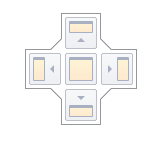Docking windows provide a rich customization experience for our software, allowing the user to redesign the layout of the application to make use of personal preferences for real screen estate - some users prefer to have all of an applications options out in plain sight, while other users prefer to concentrate solely on the task at hand without being distracted by options they don't need right now. Docking windows in the program supports a variety of distinct arrangement states to maximize this user experience.
Docking windows can be:
•Docked to the sides of window.
•Floating above window in their own separate windows.
•Collapsed to the side of window, only appearing when the user moves their cursor over the Dock Window caption.
•Tab-docked to other Dock Windows.
To dock or undock a panel, simply click its header and drag the panel. As you drag the panel over an application form, docking hints appear (see the figure below). Use these hints to dock the panel to the desired position.

Docking hints are semi-transparent square elements that allow you to dock a panel to a form's edges, or to an existing container as a tab, or between other docking elements. These hints are displayed separately or grouped in a docking guide (e.g., in the form's central area).
Finally, a docking zone is a semi-transparent preview of exactly where your panel will be docked. This zone is displayed when you drag a panel into a docking hint, but before you drop it. When a Dock Window can be docked to the edge of the window, the drag rectangle snaps into place at the appropriate edge
When dragging a dock panel, you can dock it to other dock panels. This will create a dock panel container that presents both panels as tabs. Note that in addition to docking panels via docking hints, you can also drag them to the tab header area.
This allows you to instantly rearrange panels within the container.
Dock windows have multiple state change buttons in their top right corner.
•Close - closes the current panel.
•Maximize/Restore - maximizes the panel to full-screen size or restores it back to its original size. Available only for floating panels.
•Auto-hide/Dock - hides the panel, leaving only its header visible, or restores an auto-hidden panel back to the docked state. Depending on the application settings, hidden panels are displayed either on mouse hover or on click only. Available only for docked panels.
•Pin - places the panel in the first tab position. Available only for panels docked as tabbed documents.
Most docking operations are available from the panel's context menu, displayed on right-click.
For dock panels docked as tabbed documents, the context menu displays multiple additional items, which allow you to pin the panel or start a new horizontal or vertical group within the docked area (see the image below).
Mouse Operations and Hotkeys
•Double-click a docked panel's caption - undocks the panel and makes it float. This does not work with auto-hide panels.
•Ctrl+Double-click a floating panel's caption - docks the floating panel to its previous docking position.
•Esc while dragging a panel - cancels the dock operation and drops the panel at the current position.
•Ctrl+Tab or Crtl+Shift+Tab - shows the Document Selector.
Additional Information:
When in the software main options, you have the option Restore Layout checked then program will save the current window layout
and restore at startup.
Also, you can save many different layouts by using workspace manager and restore the layout in the runtime.